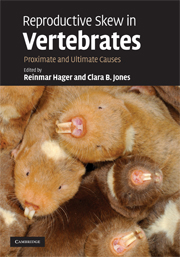Book contents
- Frontmatter
- Contents
- List of contributors
- Foreword
- Preface
- Part I Reproductive skew theory
- 1 Models of reproductive skew: outside options and the resolution of reproductive conflict
- 2 Reproductive conflict and the evolution of menopause
- Part II Testing assumptions and predictions of skew models
- Part III Resolving reproductive conflicts: behavioral and physiological mechanisms
- Part IV Future directions
- Taxonomic index
- Subject index
1 - Models of reproductive skew: outside options and the resolution of reproductive conflict
from Part I - Reproductive skew theory
Published online by Cambridge University Press: 02 February 2010
- Frontmatter
- Contents
- List of contributors
- Foreword
- Preface
- Part I Reproductive skew theory
- 1 Models of reproductive skew: outside options and the resolution of reproductive conflict
- 2 Reproductive conflict and the evolution of menopause
- Part II Testing assumptions and predictions of skew models
- Part III Resolving reproductive conflicts: behavioral and physiological mechanisms
- Part IV Future directions
- Taxonomic index
- Subject index
Summary
Summary
The two main types of skew models, transactional and compromise models, make different assumptions about the division of reproduction. Transactional models assume that one individual has full control over reproduction within the group, but may have to refrain from claiming all reproduction in order to prevent others leaving or evicting it from the group. Compromise models, by contrast, ignore outside options such as departing to breed elsewhere, but allow for incomplete control over reproduction within the group. Attempts to synthesize these two approaches have proved controversial. Here, we show that this controversy can be resolved using a simple principle from the economic literature on bargaining – the “outside option principle.” Even if outside options are available, they will influence the outcome of reproductive conflict within a group only if they yield greater payoffs than are available within the group. We present a novel synthetic model based on this principle, in which individuals engage in a tug-of-war over reproduction within a group, but may “ease off ” in their competitive effort in response to the threat of departure or eviction. We show that over a large range of parameter space, particularly when group productivity and relatedness among group members are high, these threats are not credible, so that opportunities outside the group do not influence the stable level of skew. However, when group productivity and relatedness are low, one or other of the players will typically ease off in competition in order to maintain group stability. Under these circumstances, outside options do influence skew. Tests which examine the relationship between skew and factors such as group productivity or ecological constraints are thus expected to yield variable results.
- Type
- Chapter
- Information
- Reproductive Skew in VertebratesProximate and Ultimate Causes, pp. 3 - 23Publisher: Cambridge University PressPrint publication year: 2009
- 19
- Cited by

